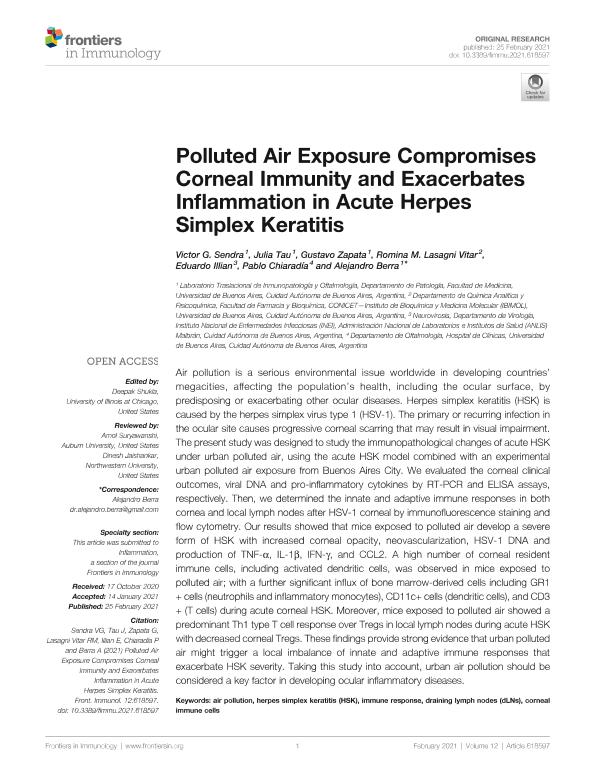Artículo
Polluted Air Exposure Compromises Corneal Immunity and Exacerbates Inflammation in Acute Herpes Simplex Keratitis
Sendra, Victor German ; Tau, Julia
; Tau, Julia ; Zapata, Gustavo Leonardo; Lasagni Vitar, Romina Mayra; Illian, Eduardo; Chiaradía, Pablo; Berra, Alejandro
; Zapata, Gustavo Leonardo; Lasagni Vitar, Romina Mayra; Illian, Eduardo; Chiaradía, Pablo; Berra, Alejandro
 ; Tau, Julia
; Tau, Julia ; Zapata, Gustavo Leonardo; Lasagni Vitar, Romina Mayra; Illian, Eduardo; Chiaradía, Pablo; Berra, Alejandro
; Zapata, Gustavo Leonardo; Lasagni Vitar, Romina Mayra; Illian, Eduardo; Chiaradía, Pablo; Berra, Alejandro
Fecha de publicación:
02/2021
Editorial:
Frontiers Media
Revista:
Frontiers in Immunology
e-ISSN:
1664-3224
Idioma:
Inglés
Tipo de recurso:
Artículo publicado
Clasificación temática:
Resumen
Air pollution is a serious environmental issue worldwide in developing countries?megacities, affecting the population?s health, including the ocular surface, bypredisposing or exacerbating other ocular diseases. Herpes simplex keratitis (HSK) iscaused by the herpes simplex virus type 1 (HSV-1). The primary or recurring infection inthe ocular site causes progressive corneal scarring that may result in visual impairment.The present study was designed to study the immunopathological changes of acute HSKunder urban polluted air, using the acute HSK model combined with an experimentalurban polluted air exposure from Buenos Aires City. We evaluated the corneal clinicaloutcomes, viral DNA and pro-inflammatory cytokines by RT-PCR and ELISA assays,respectively. Then, we determined the innate and adaptive immune responses in bothcornea and local lymph nodes after HSV-1 corneal by immunofluorescence staining andflow cytometry. Our results showed that mice exposed to polluted air develop a severeform of HSK with increased corneal opacity, neovascularization, HSV-1 DNA andproduction of TNF-a, IL-1b, IFN-g, and CCL2. A high number of corneal residentimmune cells, including activated dendritic cells, was observed in mice exposed topolluted air; with a further significant influx of bone marrow-derived cells including GR1+ cells (neutrophils and inflammatory monocytes), CD11c+ cells (dendritic cells), and CD3+ (T cells) during acute corneal HSK. Moreover, mice exposed to polluted air showed apredominant Th1 type T cell response over Tregs in local lymph nodes during acute HSKwith decreased corneal Tregs. These findings provide strong evidence that urban pollutedair might trigger a local imbalance of innate and adaptive immune responses thatexacerbate HSK severity. Taking this study into account, urban air pollution should beconsidered a key factor in developing ocular inflammatory diseases.
Archivos asociados
Licencia
Identificadores
Colecciones
Articulos(OCA HOUSSAY)
Articulos de OFICINA DE COORDINACION ADMINISTRATIVA HOUSSAY
Articulos de OFICINA DE COORDINACION ADMINISTRATIVA HOUSSAY
Citación
Sendra, Victor German; Tau, Julia; Zapata, Gustavo Leonardo; Lasagni Vitar, Romina Mayra; Illian, Eduardo; et al.; Polluted Air Exposure Compromises Corneal Immunity and Exacerbates Inflammation in Acute Herpes Simplex Keratitis; Frontiers Media; Frontiers in Immunology; 12; 618597; 2-2021; 1-13
Compartir
Altmétricas



